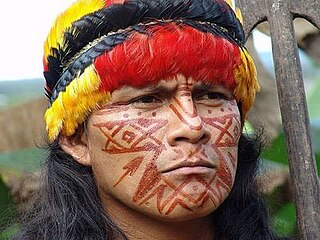
The Shuar are an Indigenous people of Ecuador and Peru. They are members of the Jivaroan peoples, who are Amazonian tribes living at the headwaters of the Marañón River.

El Oro is the southernmost of Ecuador's coastal provinces. It was named for its historically important gold production. Today it is one of the world's major exporters of bananas. The capital is Machala.

Zamora Chinchipe, Province of Zamora Chinchipe is a province of the Republic of Ecuador, located at the southeastern end of the Amazon Basin, which shares borders with the Ecuadorian provinces of Azuay and Morona Santiago to the north, Loja and Azuay to the west, and with Peru to the east and south. The province comprises an area of approximately 10,456 km² and is covered with a uniquely mountainous topography which markedly distinguishes it from the surrounding Amazonian provinces. Zamora-Chinchipe is characterized and largely identified by its mining industry; indigenous ethnic groups with a rich archaeological legacy; its biodiversity; and its niche and tourist attractions, which include a number of waterfalls well-noted for their beauty. The province takes its name from the bureaucratic fusion of the Zamora and Chinchipe cantons. The provincial capital is the city of Zamora.

Codelco is a Chilean state-owned copper mining company. It was formed in 1976 from foreign-owned copper companies that were nationalised in 1971.

The Confederation of Indigenous Nationalities of Ecuador or, more commonly, CONAIE, is Ecuador's largest indigenous rights organization. The Ecuadorian Indian movement under the leadership of CONAIE is often cited as the best-organized and most influential Indigenous movement in Latin America

The Cordillera del Cóndor is a mountain range in the eastern Andes that is shared by and part of the international border between Ecuador and Peru.
Taseko Mines Limited is a mid-tier copper producer located in British Columbia, Canada. It operates Gibraltar Mine, the second largest open-pit copper mine in Canada, and is in the planning stages for several other mines including the Prosperity Mine, Harmony, and Aley. All production is sold at non-hedged market based prices. The market capitalization currently is roughly 740 million dollars.

Southern Copper Corporation is a mining company that was founded in 1952. The current incarnation of Southern Copper can be traced to the 2005 acquisition of Southern Peru Copper Corporation by the Mexican copper producer Minera México.
Mining in Ecuador was slow to develop in comparison to other Latin American countries, in spite of large mineral reserves. As late as 2012, according to the United Nations, Ecuador received less foreign direct investment per person than any other country in Latin America. During the 1980s, mining contributed only 0.7 percent to the Ecuadorian economy and employed around 7,000 people. Minerals were located in regions with little to no access, hindering exploration. Ecuador has reserves of gold, silver, copper, zinc, uranium, lead, sulfur, kaolin and limestone. The latter practically dominated the early industry as it was used in local cement plants.
Copper mining in the Democratic Republic of the Congo mainly takes place in the Copper Belt of the southern Katanga Province of the Democratic Republic of the Congo.

Shituru is a town that is now a commune of the city of Likasi in Haut-Katanga province, Democratic Republic of the Congo. It is also the location of a copper mine, smelter and hydrometallurgical plant that was operated by the state-owned Gécamines.
Kalukundi Mine is a copper and cobalt mine being developed in Katanga Province, Democratic Republic of the Congo (DRC) by Africo Resources, a Canadian company. In September 2008 the company estimated the value of the resource as $1.47 billion.
The 2012 Ecuadorian protests were a series of demonstrations by indigenous peoples who oppose the copper mining concessions in the province of Zamora-Chinchipe. On 22 March, the protesters reached the capital Quito to be met with counter protesters and warnings from the government and President Rafael Correa.
The Fruta del Norte deposit is the largest gold deposit in Ecuador. The deposit is part of the Corriente Copper Belt located in the Amazon province of Zamora-Chinchipe.
The Tampakan deposit is a large copper and gold orebody located in the south of the Philippines in Tampakan, South Cotabato. Tampakan represents one of the largest copper resources in the Philippines and in the world having an estimated resource of 2.94 billion tonnes of ore grading 0.6% copper. The deposit also has a resource of 18 million oz of gold.
The Mirador mine is a large copper mine located in the Amazonian province of Zamora-Chinchipe in southern Ecuador. It is one of the largest copper reserves in Ecuador, and the first industrial-scale copper project to be developed in the country. The project has generated an environmental conflict that is emblematic in the national political debate on mining.
The San Carlos Panantza mine is a large copper mine located in the south of Ecuador in Zamora-Chinchipe Province. San Carlos-Panantza is one of the largest copper reserves in Ecuador and in the world having estimated reserves of 600 million tonnes of ore grading 0.59% copper. The mine is in the Corriente copper belt along with the Mirador mine. It is being developed by ExplorCobres S.A., a subsidiary of the state-owned Chinese company CRCC-Tongguan Investment Co. Ltd that is also developing Mirador.
Las Bambas copper mine is a large open-pit copper mine in Peru. The polymetallic mine is located at altitude of about 4000 meters above sea level in Challhuahuacho District of Cotabambas Province in the Apurímac Region of the southern Peruvian Andes. With over a billion tons of copper ore, the deposit is one of the largest in the world. With about 140,000 tons of copper ore are mined daily, the estimated mine life of at least 20 years. The mine produces 2% of global copper.

Shiram Diana Atamaint Wamputsar is an Ecuadorian shuar politician. She has been a member of the National Assembly. In 2018 she became the president of the Consejo Nacional Electoral (Ecuador).









